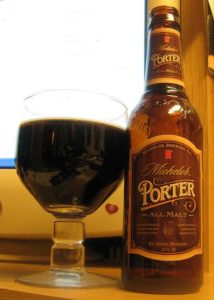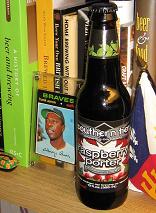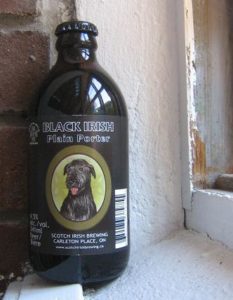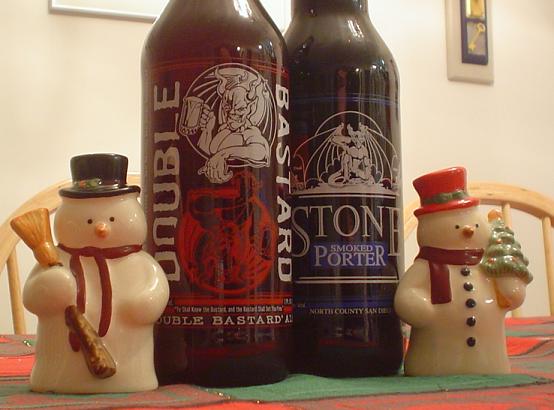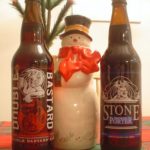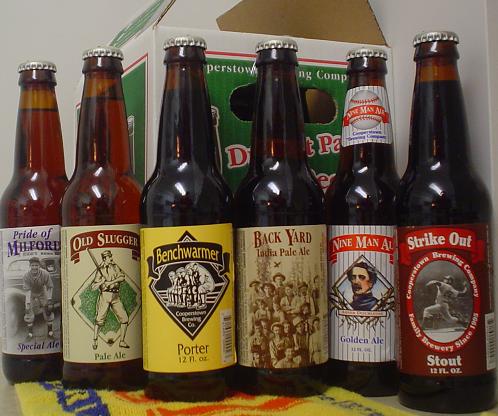
Another big buy from my trip a few weeks ago to the Party Source in Syracuse, NY. The case of this happy vista upon cracking the cardboard. Cooperstown Brewing is not actually in Cooperstown but is a proud cornerstone of the Milford, New York business community.
Like the Smuttynose case review posted ten days ago, I will work through the varieties included in this combo pack and give my impression of what the brewery is up to. One preliminary point, however. In this pack there are twelve bottles of six types as opposed to the four types. For me this takes out the “what do you think opportunity” – I don’t mind sharing a third but I think two bottles separated by a couple of days helps me think about whether I like a brew or not. Also, without having had one, drop the “golden ale”. Maybe once I have popped them, I will feel differently but to me that sounds like a pale ale that can’t work itself up to call itself even that. Plus, having sneaked one each of the stout and porter already, I know you could drop the stout. The porter is a real winner but the stout is not. You are trying to win me over with these mixed cases, so my advice is play your best cards.
I will review all six ales – and they are all ales which is a plus from the get go – as I pop ’em.
Golden Ale: I am not sure whether I have to retract what I wrote above, now a few days ago, but I am also not minding this light ale. That is what it really is at 4.3%. The brewery says:”Nine Man” is a golden ale, brewed from English pale and crystal malts, and with torrified wheat. It is bittered with Cascade and Cluster hops and finished with Cascade hops. “Nine Man Ale” was first brewed as a summer seasonal beer in 1996. It was kegged the first season but not bottled until the opening of the baseball season in April 1997.
– Original Gravity 1.045 / Final Gravity 1.012 /4.3% abv.
There is more body in this than a supposedly full-bodied Canadian macro-ale like Labatt 50. The hop selection and timing provides a good edge to the brew without florals or fruity flavour – maybe a wee lemon rind thing. The crystal malt gives it a slight nutty tone as well. Nothing remarkable except that at that moderate alcohol level, it does not come across as any kind of compromise. The beer advocatonians are a little restless with a 19% thumbs down rating. Here is one unhappy soul’s tale:Found this to be a decent, quaffable light ale. It has a pleasant medium gold appearance with a slight head. The aroma has hints of mown grass with some hints of Saaz hops. Tart, slightly fruity flavor. At the end, find it to be a bit clingy and starchy on the aftertaste.That reviewer rated it 2.9 out of 5. What do you want from a light ale?!?! But that is it! It is not called a light ale or even a lite one but a golden one. By not admitting what it is, has Cooperstown lost a market? Perhaps. For now, I say leave three of these in the box…maybe as a summer seasonal.
Pride of Milford: Strong Ale. The brewery says 7.7% which is about 2.2% higher than I would have guessed from the mouthfeel. It is rich but not Belgian fruity, more restrained like a low-end barley wine. The excellent Lew Bryson in his excellent, nay, seminal New York Breweries (1st ed. 2003 Stackpole Books) calls it at page 166:…a big beer that showcases the beautiful character of the Yorkshire [Ringwood] yeast. It’s malty, cookie-sweet and touched by fruity esters and Ringwood nuttiness that I love…I would agree with everything but the “cookie-sweet” unless we are talking ginger snap or milk lunch. I think this is actually moderately rich and dry – think amontillado or oloroso rather than fino if we were taking sherry which we are not but I thought I would say it anyway. The brewery says:
“Pride of Milford” is a very special ale with a tapestry of complex flavors and aromas. It is brewed with five malts and fermented with the Ringwood yeast at a higher temperature which gives this beer a uniqueness all its own. “Pride” has a distinctive reddish copper color. It is strong and rich beer. When “Pride” was first brewed in December 1999, many thought the flavor and aromas of this beer had fruit overtones. No fruit or adjunct flavoring is added to this beer. The unique flavor comes from our special brewing process.
It is not particularly pungent and has a soft mouthfeel, which would make it quite sneaky if one faced an afternoon at a cottage in winter with a fridgefull. Which raises the question of why this would be included in a case in July. I say include three of these in the case in winter replaced by the Golden Ale in the summer. I think beerish advocates would agree.
Strike Out Stout: The head fizzed like a Coke as it was poured and dissolved away within ten seconds. A nice flavour with chocolate and dry darker malts but subdued, a lighter bodied stout. An oxymoron. Fades in the mouth leaving a cocoa-chalky feel then just a little sour tang. The brewery is kinder to itself:
“Strike Out” is brewed with 6 malts including a balanced portion of chocolate and crystal malts. It is also brewed with 5% flaked oats for a velvet-like mouth feel. English pale, Munich and black malt, plus roasted barley round out the malt bill. Considerably lower in alcohol than both Benchwarmer Porter and Old Slugger Pale Ale, “Strike Out” is a well-rounded stout, opaque black in color with a roasted palate.
People looking for a stout will be disappointed, especially with the 4.6% but also the crystal malt, quite off style, even for an oatmeal stout. Consider these
two great oatmeal stouts
easily accessible to someone in the east end of Lake Ontario region. Both have richness. Strike Out does not. It should be reformulated with some body added or it should be called a dark ale, a lesser style. The yeast is a bit sour, too. Not really on for the style. I think I have made a stout like this and not been that proud of it.
One unhappy beer advocate
Almost black. Big Huge fizzy brown head. Good retention. Head forms craters as it dissintegrates. This beer appears to be very charged up by its appearance. Coffee bean, soap and leather are present on the nose. There’s something wrong with this beer. (Actually, many things.) Mouthfeel is way too carbonated. I get so damn much gas in every gulp that a burp is always the aftermath. The taste is astringent. Husky. Tannin like. Soapy. Stale. No stout qualities to speak of. I haven’t dumped a beer in months, but I just don’t feel like burping 20 times by the time I finish this one.
So ditch this beer, Cooperstown. I think I am going to like the porter better from the recollection of the first. Leave this one out of the variety case to make some room of the seasonal.
Old Slugger Pale Ale: If there are two words that are bad in beer they are “Mt.” and “Hood”. Some call them spicy. Others, like me, rough and dirty, like a little bit of bark in every sip. I didn’t know what was so odd about this brew until I saw those two words – then I knew. Al Korzonas in his text Homebrewing – Vol. 1 (Sheaf & Vine, 1997) writes:
Another recently released American-grown cousin of Hallertauer Mittlefrüh. It is spicy (cinnamon), resiny and slightly sweet. It is recommended for any German or American lager. It is quite close to the Hallettaur Mittlefrüh in character, perhaps a little spicier. I recommend against using this hop for beers in which you want dominant bitterness – in a recent experiment I found its bitterness to be slightly abrasive when used in a recipe where the bitterness strongly dominated the malt.
Not good news for a pale ale – that fairly malty, fairly bitter style.
Don’t get me wrong. This is an ambitious brew – ringwood yeast and its sour, woodsy thing; three very different hops, Mt. Hood as well as twiggy Fuggles and citrusy Cascade; as well as four barley malts including two types of crystal. For all that work there is an absence of finesse, the balance that makes all that flavour pull together. What would help? There is butterscotch but it is sitting there in a gap that needs to be filled up with biscuit. Again with the body…Cooperstown is just making them too light for the amount of flavour they want you to take in. Like the stout, it leaves you with an impression that it is thinner than it ought to be. Also like the stout, the head disappeared fast. The beer advocates give at a fairly low average for a micro.
Back Yard India Pale Ale: The head sustains longer than the stout or the pale ale. This is a good sign. The first taste is of vegetative rather than herbal hops. Clover sweet. There is a rough malt grain edge but is works in this one. This beer would go well with rich earthy flavours like ox-tail soup, parsley potato soup or roast squash. You know what I saying. I know you do. Maybe it is just that the ringwood challenge has been met with this one. A full three ales in the variety pack year round.
Interestingly, the unhappy beer advocates are talking about gushing bottles, cloudy ale and high burposity. These comments all go to problems at the brewery. My bottle was nothing like this, fairly still and balanced. So be prepared for bottle variation. The brewery says something very interesting:
English pale barley malt is predominant in this beer with just a small amount of crystal malt. It is well bittered with Cluster and Cascade hops and finished with a mix of local hop and larger amounts of Fuggle hop.The southeast zone of the leather-stocking region in New York (west of the Syracuse-Binghampton corridor south-west of Albany) was a hop growing area before the west was truly won and a local hop is a good hop if it is a heritage variety as this claim might be taken to imply. All in all, I am very happy with this beer. No Flower Power IPA from Ithaca but a worthy if less brassy neighbour. Redemption in the case.
Benchwarmer Porter: Comfort beer and, again like the IPA, a worthy placement in the case. The head is rocky and tan. The mouthfeel is full and full of mocha and fresh picked unsweetened black current. A beer fit for the Ringwood, but porter usually is. I used to make Ringwood pumpkin porter in my homebrewing days…but less about me, more about the brew. The brewery says:More than 4% chocolate malt, which is the most similar to the brown malts of the early 1700’s, gives “Benchwarmer” its dry coffee-like finish. It is fermented with the Ringwood yeast which is an excellent yeast for the brewing of porters.I am buying it but are the beer advocates? 43 reviews all all positive. One says:
Big foamy head and very dark color, but not opaque. Lots of hops for a porter, and they work well in drying out a slightly chewy mouthfeel, as well as imparting nice hints of herbs and dry leaves. Very tasty underlying flavors of espresso, dry molasses and earth. The finish is dry, with the coffee/espresso flavors lingering with a touch of alcohol. Really complex on tap.
Many reviewers taste some smoke which I did not get at all. Oh, well. Such is life. Very decent porter.
So all in all this is an ok variety pack but I now know what I will buy in a six and what I will not. Some concern for production quality but when they do well they do well. Nothing life changing but they are thinking and they are achieving – two things I have to remember to get around to from time to time Work on the stout and the pale ale, mix up the case to go with four styles not six and you are going to be ok.
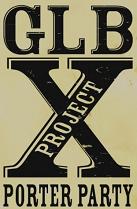 I was handed this beer at last week‘s beer event. I just would like to mention that this is one of the best Ontario-made beers I have ever had. Part of their Project X series, it’s on limited release and, sadly, limited production. Too bad. Thick sheeting mocha cream head over deep dark ale. Thick aroma, too. Cocoa and mint. Pumpernickel and cream. If I had thought of a beer future back in the 90s, it might have been this. Before hop mania. Before sour. When malt and roast reigned. This has it. Masses of dark malt with dry roast coffee as well as sticky date and raisin notes all carried along with a rich light sour even yogurty yeastiness. It is heavy. In the best sense. As heavy as you wished your coffee in the morning could be.
I was handed this beer at last week‘s beer event. I just would like to mention that this is one of the best Ontario-made beers I have ever had. Part of their Project X series, it’s on limited release and, sadly, limited production. Too bad. Thick sheeting mocha cream head over deep dark ale. Thick aroma, too. Cocoa and mint. Pumpernickel and cream. If I had thought of a beer future back in the 90s, it might have been this. Before hop mania. Before sour. When malt and roast reigned. This has it. Masses of dark malt with dry roast coffee as well as sticky date and raisin notes all carried along with a rich light sour even yogurty yeastiness. It is heavy. In the best sense. As heavy as you wished your coffee in the morning could be.

